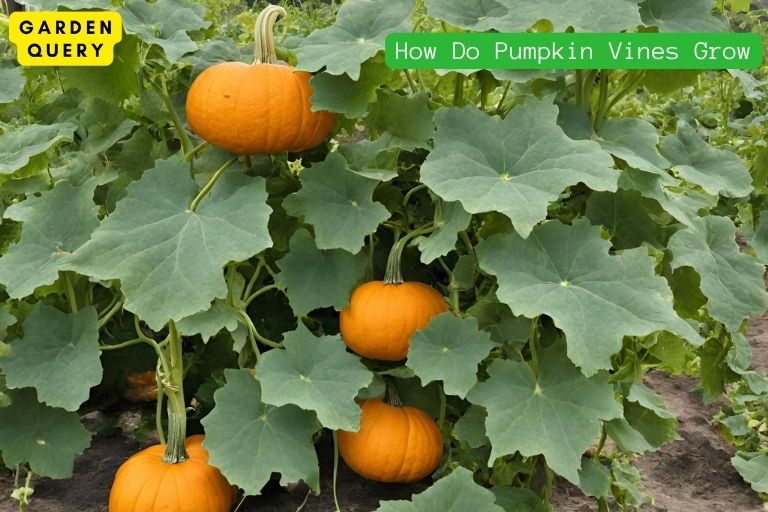How Do Pumpkin Vines Grow?
Pumpkin vines grow by sprouting from seeds, developing long, sprawling stems that creep along the ground or climb on supportive structures.
Pumpkin vines initiate their growth from planted seeds, requiring warm temperatures and adequate moisture to germinate.
As the seeds sprout, they send out long stems that extend horizontally along the ground or upward if provided with suitable support.
These vines produce tendrils, enabling them to attach and climb structures nearby.
The stems continually elongate, branching out with large leaves that aid in photosynthesis, supporting the plant’s growth.
Throughout the growing season, the vines expand, facilitating the development of flowers and pumpkins.
Key Takeaway

Pumpkin Vines Grow
What are pumpkin vines?
Pumpkin vines are long, trailing plants that belong to the Cucurbitaceae family. They are known for their large, orange fruits that are commonly used for carving during
Halloween or for making delicious pies and desserts. Pumpkin vines can grow to impressive lengths, reaching up to 20 feet or more.
These sprawling plants produce curly tendrils that help them climb and anchor themselves as they grow.
Benefits of growing pumpkin vines
Growing pumpkin vines in your garden can offer several benefits beyond the tasty pumpkin harvest.
Here are a few reasons why you might consider cultivating pumpkin vines:
Abundant harvest: Pumpkin vines are vigorous growers, and they can produce a bountiful harvest of pumpkins. This means you’ll have plenty of pumpkins for cooking, carving, or decorating.
Decorative appeal: Pumpkin vines can add a touch of beauty to your garden. Their large, vibrant green leaves and bright orange fruits create a charming and festive atmosphere, especially during the fall season.
Nutrient-rich soil: As pumpkin vines grow, they send out numerous roots that help to stabilize the soil, prevent erosion, and improve soil structure. Additionally, pumpkin plants are heavy feeders, drawing up nutrients from the soil and making them available for other plants when the vines decompose.
Pest deterrent: Pumpkin vines contain natural compounds that repel certain pests, including beetles and squash bugs. By growing pumpkin vines alongside other plants, you can help protect your garden from these unwanted pests.
Environmental benefits: Like other plants, pumpkin vines play a role in reducing carbon dioxide levels and providing oxygen through photosynthesis. Growing pumpkin vines can help contribute to a healthier and more sustainable environment.
Whether you’re a gardening enthusiast or simply want to enjoy the beauty and benefits of growing pumpkin vines, they can be a rewarding addition to your garden.
Provide adequate spacing and support for the vines to ensure healthy growth and a plentiful harvest.
Read More: Pumpkin
Pumpkin Vine Growth Cycle
Have you ever wondered how those big, vibrant pumpkin vines grow? Well, it all starts with a little seed and some favorable growing conditions.
Seed germination and sprouting
The first stage in the growth cycle of a pumpkin vine is seed germination. When provided with adequate moisture and warmth, the seed swells and absorbs water, which triggers the germination process.
The seed then splits open, and the embryonic root, also known as the radicle, emerges from the seed.
Shortly after, the stems and leaves begin to emerge from the soil, and the sprout starts its journey towards becoming a full-grown vine.
Development of vines and leaves
As the pumpkin vine continues to grow, it produces more foliage, which plays a vital role in the plant's photosynthesis process.
The leaves capture sunlight and convert it into energy to fuel the growth and development of the plant.
The vines grow longer and start to spread out, seeking support from nearby structures or trellises as they expand.
Did you know: Pumpkin vines are equipped with tendrils that allow them to latch onto objects for support, ensuring that they can grow upward and outward.
Throughout this growth stage, the plant also produces flowers, which are essential for pollination and the eventual formation of pumpkins.
Bees and other pollinators play a vital role in transferring pollen from the male flowers to the female flowers, enabling fertilization to occur.
Once the pollination process is successful, small green pumpkins begin to form, and they gradually enlarge over time.
As the pumpkins ripen, their vibrant orange color develops, indicating that they are ready for harvest.
Fun fact: Pumpkin vines are known for their rapid growth rate, often expanding several inches or more each day under optimal growing conditions.
The growth cycle of pumpkin vines is a remarkable process that starts with seed germination and progresses through the development of vines, leaves, flowers, and eventually pumpkins.
With the right care and nurturing, you can enjoy the beauty of watching these vine tendrils reach out and witness the transformation from a tiny seed to a sprawling pumpkin plant.
So next time you see a pumpkin vine, remember the incredible journey it has embarked upon to reach that point.
Read More: How Are Pumpkins Made?
Factors Affecting Pumpkin Vine Growth
Pumpkins are a staple of autumn, with their vibrant colors and delicious flavor.
If you’ve ever wanted to grow your own pumpkins, it’s essential to understand the factors that affect their vine growth.
By optimizing these factors, you can ensure healthy and robust pumpkin vines.
Sunlight and temperature requirements
Pumpkins thrive in warm and sunny conditions, making it crucial to provide them with ample sunlight.
The ideal amount is at least six hours of direct sunlight per day. Without sufficient light, the vines may become weak and leggy, and the pumpkins may not reach their full potential.
Sunlight, pumpkins also require the right temperature for optimal growth. They prefer temperatures between 70-85°F (21-29°C).
Temperatures below 50°F (10°C) can stunt growth or even kill the vines.
If you live in a region with cooler temperatures, consider using protective coverings or starting your pumpkin plants indoors before transplanting them outdoors.
Soil type and fertility
Choosing the right soil for your pumpkin vines is vital to their growth and productivity. They prefer well-drained soil rich in organic matter.
Sandy loam or loamy soil types are ideal as they provide good drainage while retaining moisture. It’s advisable to prepare the soil by adding compost or well-rotted manure to enhance fertility and nourish the vines.
Pumpkins are heavy feeders, meaning they require a nutrient-rich soil to thrive. Providing regular applications of organic fertilizers, such as compost or aged manure, can help ensure optimal growth.
Avoid using excessive amounts of nitrogen, as this can result in lush foliage but fewer fruits.
Proper spacing between pumpkin plants is also essential for their growth. Each plant should have enough room to spread out and receive adequate airflow and sunlight.
This helps prevent diseases and promotes vigorous vine development.
Understanding the factors that affect pumpkin vine growth is crucial for successful cultivation.
By providing ample sunlight, maintaining the right temperature, choosing well-drained soil, and ensuring proper spacing, you can create an optimal environment for your pumpkin vines to thrive.
With a little care and attention, you’ll soon be harvesting your own delicious homegrown pumpkins. So don’t wait any longer – get ready to enjoy the fruits of your labor!
Read More: How Are Pumpkins Pollinated?
Care and Maintenance of Pumpkin Vines
Growing pumpkins can be a rewarding experience, but it requires proper care and maintenance to ensure healthy and productive vines.
Whether you are a seasoned gardener or a novice, here are some key points to consider when it comes to caring for your pumpkin vines.
Watering and irrigation techniques
Pumpkin vines require consistent watering to thrive and produce quality fruit. It is important to provide them with an adequate amount of water, especially during the hot summer months.
Overwatering can lead to rot and diseases, so it's crucial to find the right balance.
- Deep watering: Instead of frequent shallow watering, it is best to water the plants deeply, ensuring the water reaches the roots. This encourages the roots to grow deeper, making the plants more resistant to drought.
- Watering schedule: Establish a regular watering schedule, maintaining consistent moisture levels in the soil. Watering in the early morning or late afternoon is ideal to prevent the leaves from staying wet overnight, which can lead to fungal diseases.
- Mulching: Applying a layer of organic mulch around the base of the plants helps retain moisture in the soil and prevents weed growth. It also acts as an insulator, keeping the roots cool during hot days.
Pruning and training vines
Proper pruning and training of pumpkin vines can help improve air circulation, reduce the risk of diseases, and keep the plants more manageable.
Here are some guidelines to follow:
- Vine training: As the vines grow, gently guide them along a trellis or fence, allowing them to climb and spread in a controlled manner. This helps prevent the fruits from resting on the ground, reducing the risk of rot and pests.
- Removing suckers: Suckers are the small shoots that develop in the leaf axils of the main vines. They compete for nutrients and can hinder the growth of the main plant. Regularly remove these suckers to encourage the development of stronger, more productive vines.
- Pruning excess foliage: Removing some of the leaves and foliage can improve air circulation, reduce the risk of disease, and allow more sunlight to reach the developing fruits. However, be careful not to remove too many leaves, as they are important for photosynthesis and fruit development.
By following these care and maintenance tips, you can ensure that your pumpkin vines grow healthy and produce an abundant harvest.
Monitor for pests and diseases regularly, and make adjustments to your care routine as needed. With proper care, you’ll be rewarded with beautiful pumpkins in no time!
Common Problems and Solutions
Pest and disease management
When it comes to growing pumpkin vines, it's important to be aware of potential pest and disease issues that can hinder their growth.
Some common pests that can be a problem for pumpkin vines include aphids, squash bugs, and cucumber beetles. These pests can cause damage to the leaves, stems, and fruit of the plant.
One effective way to manage pests is by regularly inspecting your plants and removing any pests that you find.
You can also use organic pest control methods, such as neem oil or insecticidal soaps, to keep these pests at bay.
Planting companion plants like marigolds or nasturtiums can help deter pests from your pumpkin vines.
In terms of diseases, powdery mildew is a common issue that affects pumpkin vines. This fungal disease appears as a white, powdery coating on the leaves and can hinder the plant’s growth.
To prevent powdery mildew, make sure to provide adequate air circulation around your plants by properly spacing them.
Watering the soil instead of the foliage can also help prevent this disease.
Preventing vine diseases
Powdery mildew, there are other vine diseases that can impact the growth of pumpkin vines, such as downy mildew and bacterial wilt.
These diseases can cause wilting, yellowing of leaves, and stunted growth.
One way to prevent vine diseases is by planting disease-resistant pumpkin varieties. These varieties have been bred to have increased resistance to common diseases, reducing the likelihood of your plants getting infected.
Practicing good sanitation in your garden, such as removing and disposing of infected plant material, can help prevent the spread of diseases.
It's also important to provide proper care for your pumpkin vines to keep them strong and healthy.
This includes providing them with sufficient water, sunlight, and nutrients. Mulching around the base of the plants can help retain soil moisture and prevent weed growth.
By being proactive in managing pests and diseases, and providing proper care for your pumpkin vines, you can ensure their healthy growth and maximize your harvest.
Harvesting and Using Pumpkin Vines
It’s that time of year when pumpkins are popping up everywhere. From decorations to pies, these versatile gourds have a place in our autumn traditions.
But have you ever wondered how the pumpkin vines grow and how you can make the most of them?
Signs of pumpkin vine readiness for harvest
Before you start harvesting your pumpkin vines, it’s important to know when they are ready.
Here are a few signs to look out for:
- Maturity: As the pumpkin vine grows, it will mature and develop a tough outer skin. When the skin changes from green to a deep orange or yellow, it’s a good indication that the vine is ready to be harvested.
- Drying Vines: Another sign is when the vines start to dry out and wither. This means that the plant has stopped producing new pumpkins and is preparing for the end of its growing season. Once the vines have dried up, it’s time to cut them off and start harvesting the pumpkins.
- Full Color: Check the pumpkins themselves for a full, vibrant color. Avoid harvesting any pumpkins that still have green patches, as they won’t ripen properly off the vine.
Creative uses for pumpkin vines
Once you have harvested your pumpkins, don't let the vines go to waste.
There are several creative uses for them:
- Decorations: Dried pumpkin vines can be made into wreaths, garlands, or rustic table centerpieces. Get creative with your arrangements and add some autumn charm to your home.
- Compost: Pumpkin vines are a great addition to your compost pile. They break down quickly and add rich organic matter to enrich your soil for future gardening endeavors.
- Animal Feed: If you have farm animals, they will love snacking on pumpkin vines. They are a nutritious treat and can be given as a supplement to their regular diet.
- Craft Projects: Use dried pumpkin vines to create unique crafts like baskets, birdhouses, or even small furniture pieces. Let your imagination run wild and see what you can come up with.
Pumpkin vines are a valuable resource that can be repurposed in many ways. Don't let them go to waste after harvesting your pumpkins. Get creative and make the most out of these versatile plants!
Here’s a table summarizing the signs of pumpkin vine readiness for harvest:
| Signs of readiness for harvest |
|---|
| Maturity: Look for a change in skin color from green to orange/yellow. |
| Drying Vines: When the vines start to dry out and wither. |
| Full Color: Ensure the pumpkins have a full, vibrant color. |
Summary
Understanding the growth dynamics of pumpkin vines reveals their remarkable adaptation in utilizing tendrils, leaves, and flowers to support the development of pumpkins.
By providing the necessary conditions of sunlight, water, and space, enthusiasts can witness the captivating journey of these vines as they sprawl, flower, and eventually bear the iconic pumpkins.
Embracing this growth process adds a deeper appreciation for the natural marvels of pumpkin cultivation.
- Best Therapists In Dallas - February 1, 2024
- Holly Willoughby Husband: Holly Willoughby’s Love Story - January 30, 2024
- Holly Willoughby Dress: 5 Style Secrets and 7 Must-Know Career Milestones - January 30, 2024





